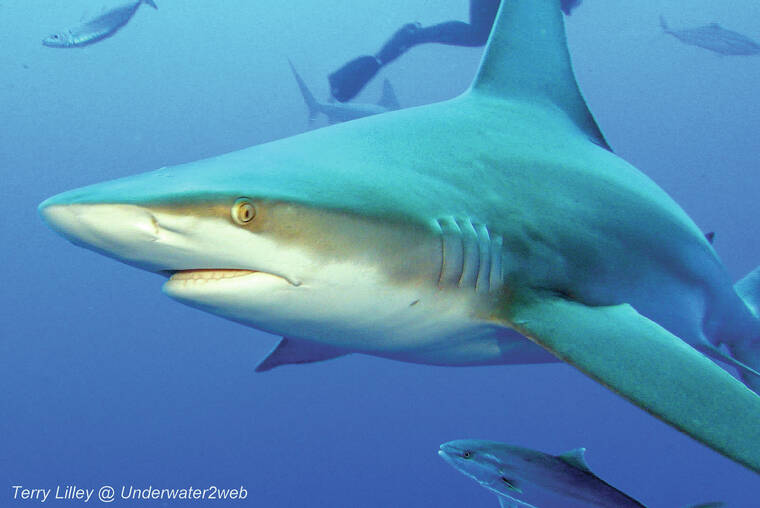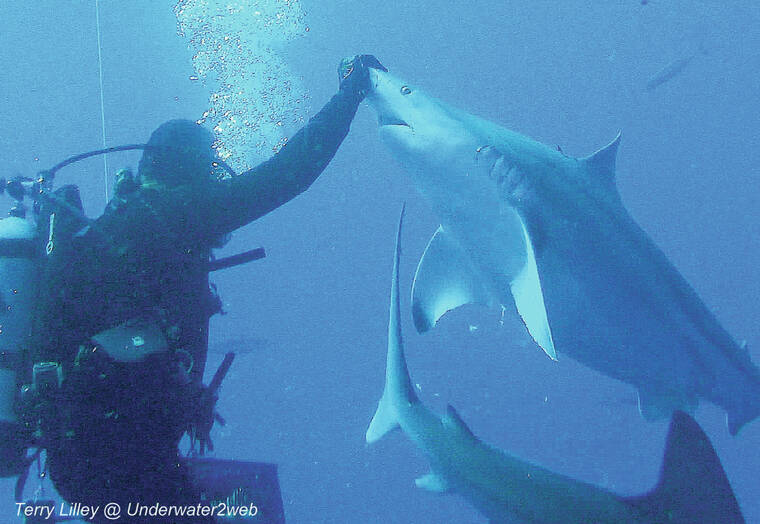I was surfing in Hanalei Bay one sunny afternoon with a group of friends that surf there often, and we were all talking about sharks while we waited for a set to roll in.
I am on the TV show every summer about shark attacks that airs on National Geographic, so a lot of the surfers want my opinion about why sometimes sharks bite surfers. My usual answer is surfers are not on the big sharks menu, but sometimes they accidentally bite a surfer when they are chasing their normal prey item like a sea turtle. This only happens a few times a year in the entire world, so it is really not something to worry about.
We all looked out to sea and saw a big set coming in, so we paddled hard and I turned around on the first wave with two of my friends. Just when we stood up a giant tiger sharks launched out of the water right in front of us with a big turtle in his mouth.
The shark went high enough that we were looking at the sharks tail only a few feet away. I ended up riding the wave a short while and my two buddies kicked out of the wave right next to the shark as it crashed back down into the water. Then everybody started freaking out.
What do you do when a 14-foot shark is trying to catch a turtle right next to your legs? Some of the surfers put their legs up on their boards and others started paddling toward shore at record speeds. I was paddling back out and when I saw the shark I got off my surfboard and laid in the water as I know that the shark wont bite me if it knows I am a human, but it could accidentally bite a surfboard thinking it was a turtle.
Sound crazy, well maybe not. I kept surfing for another hour and had perfect six-foot Hanalei all to myself!
Recently, I was scuba diving in Florida at 100 feet deep in the Gulf Stream with some shark divers and 30 giant 400 pound lemon sharks along with 20 huge bull sharks and a lone tiger shark. We did this dive on purpose and were even feeding the sharks small scraps of fish.
All surfers and swimmers want to know what to do if a big sharks tries to attack them. Some people say you need to poke the shark in the eyes. Others say you hit the shark on the nose and some say you swim like heck to get out of the water, but we did just the opposite and lived to tell about it.
Sharks have very sensitive electromagnetic receptors on their snout, face and top of their head. They use these receptors to find food, so the sharks face is very sensitive to touch. The shark dive instructor we were with told us that the big sharks will come so close to us that they will bump into you knocking you sideways while holding a big camera in a current at 100 feet deep!
Sure enough that happened several times. I was hit in the back, sides and even had a huge 12-foot long lemon shark bite my camera video light! We were told that when the sharks get to close for comfort just gently put your hand on top of their head and push them away. Sharks can’t bite upward while moving, so your hand is safe on their head and for some reason I still don’t understand, the big sharks moved away and went about their business peacefully every time we pushed them away.
We had to push away well over a dozen big sharks on the dive and not one of them seemed the least bit bothered by it. They seem to lean quickly to keep their distance even though they were zooming around showing off their rack of big teeth. After a while it felt like we were in a room with 30 large golden retriever dogs and we just had to show them whose boss to keep control so they all got along together.
In two weeks we are going to Tiger Beach in the Grand Bahamas to dive with four to eight 15-foot plus tiger sharks. We are told that we keep control of them in the same way. If they get too close just put your hand on their head and push them away as if you were telling your big dog to calm down and stop bugging your friends.
We still do not know a lot about shark behavior, but we do now they are very controlled underwater, cooperate with each other and only bite what they are feeding on. Being able to calmly push away a 16-foot shark underwater with your hand opens up a whole new realm of shark behavior. And shark divers are doing this worldwide with great success even with 20-foot long great white sharks.
You can see all of our shark diving pictures and movies and watch this new human versus shark behavior up on my Facebook page under my name Terry Lilley. Sharks clean up the sea as they eat all the dead stuff so we need them for a healthy ocean; and we are showing daily that sharks do not eat people and they will even cooperate with you underwater as long as you know how to speak their language.
•••
Terry Lilley is a marine biologist living in Hanalei Kaua‘i and co-founder of Reef Guardians Hawai‘i, a nonprofit on a mission to provide education and resources to protect the coral reef. To donate to Reef Guardians Hawai‘i go to www.reefguardianshawaii.org.







Very informative! Thank you!